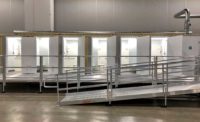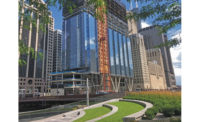The contracting industry in the Midwest bounced back and set new records for revenue in 2021, according to respondents in ENR’s Top Contractors survey. Ninety-six firms from all 11 states in the region reported a record-breaking total of $50.3 billion in 2021 revenue. The previous high for revenue came in pre-pandemic 2019 with $42.5 billion, then dipped to $41.3 billion in 2020, when 85 contractors responded to the survey.
Chicago-based Clayco led the way with $4.98 billion in 2021 revenue, followed by Turner Construction of Columbus, Ohio, which had $3.1 billion.
Related Link:
ENR Midwest 2022 Top Contractors Rankings
Barton Malow of Southfield, Mich., another mainstay on the ENR Midwest list, came in third with $2.67 billion. The Southfield, Mich.–based company relied heavily on the education, health care and research and development facilities sectors.
Clayco, Turner and Barton Malow were the only companies to top $2 billion. The top five companies were rounded out by Ryan Cos. US, headquartered in Minneapolis, which had $1.85 billion and Chicago’s The Walsh Group with $1.57 billion.
A total of 19 companies broke the $1-billion mark in 2021. Other top revenue producers were the Kokosing Group of Cos. of Westerville, Ohio, and Walbridge of Detroit, both with about $1.37 billion, Mortenson of Minneapolis, also with $1.37 billion, Kiewit Corp. of Omaha with $1.33 billion and J.D. Dunn Construction of Kansas City, Mo., with $1.33 billion.
As it has in the past, the range of projects the top contractors produced spanned a wide array—from pet food plants in Ohio to campus expansions in Kansas, casinos in Illinois and high schools in Nebraska. Chicago-based W.E. O’Neil Construction can even boast of having won the concrete subcontract for the Obama Presidential Library.
The health care sector was the leading area of revenue with the top contractors bringing in $4.9 billion. The distribution and warehouses sector was a close second at $4.7 billion.
Turner is no stranger to the Top Contractors list. The company finished second two years ago with revenue of $2.99 billion and was named Contractor of the Year in 2020. The largest chunks of that came from $1.6 billion of revenue in Ohio and $1 billion in Kansas, and like most firms on the list, health care was its biggest sector, generating revenue of $561 million.
“Data centers and health care continue to be our largest market segments, but we also have significant work in the public, life sciences, industrial and multifamily markets,” says Kyle Rooney, senior vice president and regional manager at Turner. “These markets have either been less affected by the pandemic or positively affected. With eight long-term established offices in the Midwest, we are able to furnish talented local resources to those markets and the projects they provide.”
One of Turner’s largest projects came in its own regional backyard—a four-year, $65-million renovation of the 43-story Rhodes Tower in downtown Columbus. Turner served as construction manager, overseeing 60 workers on site each day. Crews worked at night replacing windows so as not to disturb office employees working during the day. In addition, protective netting was added to the 41st floor not just to protect the workers, but also the territorial peregrine falcons that typically nest in the area.
Toldeo-based Dunbar Mechanical Inc. (85th on the list with regional revenue of $75 million) worked on ConAgra Project Saunders in nearby Archbold, Ohio. The ConAgra plant produces such items as Vienna sausages, Ramen noodles and Manwich sauce. Dunbar acted as the lead contractor and self-performed piping, HVAC installation and plumbing as well as coordinated the electricians and civil work to be done over the course of the 18-month project that was completed in summer 2021. New production lines were added for goods such as Hunts and Manwich. “We literally put in a new production process, adding material handlers, washers, cookers …” says Donald Yerks, Dunbar director of marketing and business development.
According to Yerks, the company’s biggest challenge was working in an operating food plant without impacting the product or compromising food safety. That placed pressure on Dunbar, because ConAgra needed to make sure their food products were still hitting the grocery shelves on time. As Yerks says, “If you tell consumers, ‘We’re going to have product for you August 1st,’ you’d better have it by August 1st, because food vendors can lose their preferred shelf space.” The problem was easily handled by routing utilities through the plant while coordinating everything with plant managers and the production team.
“Clearly workforce shortages and supply chain disruptions are the greatest challenges our industry faces for the foreseeable future.”
—Kyle Rooney, Senior Vice President and Regional Manager, Turner Construction Co.
Like others in the industry, Dunbar had a much better 2021 in terms of revenue than it did the previous year. It was their second-best year in company history. But Yerks says the company is keeping an eye on price volatility and inflation and is concerned with the cost of capital along with meeting consumer demands.
Over the past 10 years, he says customers have extended payment terms.
“Contractors didn’t like it, but we generally didn’t argue,” he says. “But now, all of a sudden, your line of credit is at 6%, 7%, 8%. That’s a big move. You’re going to have some cash flow squeezes.”
Another company that performed well in 2021 is Appleton, Wis.-based The Boldt Co., which relied heavily on its home state and the education and health care sectors. It was ranked No. 22 with $676 million in revenue.
The firm attributed more than a third of its revenue ($288 million) in Wisconsin and more than a third to the health care sector ($227 million). A large part of that was the company’s work on the Milwaukee Regional Medical Center’s thermal power plant. Boldt served as the general contractor and construction manager on the project, along with architect/engineer Burns & McDonnell.
The project required planning and construction of upgrades to the entire district energy system. Boldt constructed a transitional plant to hold four 70,000 lb/hour steam-generating gas boilers so that the existing boilers could be taken off line. Boldt then renovated the existing plant and replaced four boilers, added three new chillers and replaced three chilled water pumps. They constructed a four-cell cooling tower, added office space, locker facilities and control rooms and expanded the distribution system so as to add 8,200 ft of water piping.
While the industry overall has rebounded from the pandemic in terms of revenue, both Rooney and Boldt President Dave Kievet say supply chain issues and a labor shortage threaten contractors nationwide.
“Clearly workforce shortages and supply chain disruptions are the greatest challenges our industry faces for the foreseeable future,” Rooney says.
“I was thinking we’d crawl out of the supply chain issues by now, but obviously that hasn’t happened,” Kievet notes. “The big question is how do we keep construction supplies coming? You can’t get door frames in three days now. So you’re seeing architects and designers and owners collaborate to get more easily accessible materials. But from my perspective, the supply chain issue is exciting because it’s a challenge to overcome. It’s why we have to improve our company. It helps solve the labor issue [as potential employees realize] ‘I want to work for Boldt Co. because they can handle it and figure it out.’ As with any crisis it’s an opportunity.”





Post a comment to this article
Report Abusive Comment